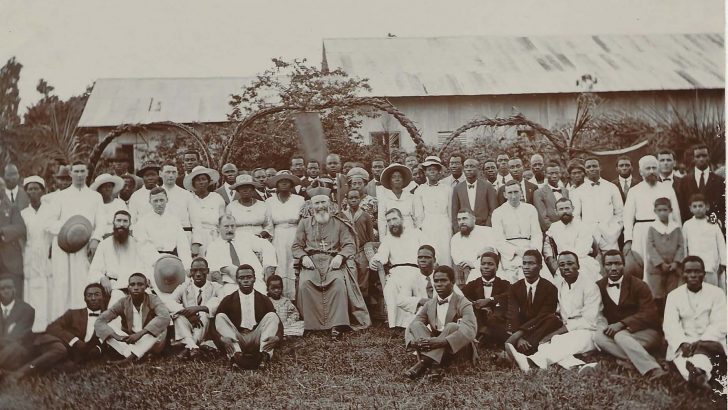Irishman Bishop Joseph Shanahan’s impact in Nigeria continues 100 years on, Sr Chinyeaka Ezeani MSHR tells Ruadhán Jones
Bishop Joseph Shanahan is not a household name in Ireland. But in parts of Nigeria, it’s hard to move without seeing his name: schools, colleges, hospitals and halls all bare the name of “Nigeria’s St Patrick”, Sr Chinyeaka Ezeani says. She is a sister in the order Bishop Shanahan founded in 1924, the Missionary Sisters of the Holy Rosary, for the express purpose of aiding the bishop in the conversion of Southern Nigeria.
“Since we initiated the cause for his beatification and canonisation in 1997, we have tried to promote among the younger people who didn’t know the missionaries, and we have tried to promote his cause, but his name is all over the place,” Sr Ezeani explains. “His name is familiar at home.”
In Nigeria, the sister continues, everybody believes he is a saint – but his name has streched far across the globe, from Ireland to Australia.
Saint
“In Nigeria, everybody believes that he was a saint,” Sr Ezeani says. “Here in Ireland too, sometimes we get people who pray for intercession through him. Some people have received favours, we get letters from as far away as Australia. In Nigeria, every year around June, his anniversary, they have a day called Shanahan day. All the dioceses celebrate his life, as a way of keeping his memory alive, and also as a way of promoting his cause for canonisation.”
His cause for canonisation is still at the diocesan stage, Sr Ezeani explains, the process being quite a long one. The cause was initiated in Onitsha, Nigeria, but the Holy Rosary sisters are seeking information from all round the globe.
“Because there are witnesses, a lot of people in Ireland couldn’t travel to Nigeria,” Sr Ezeani continues. “A lot of them were already elderly or not so well. Permission was given to open a kind of rogatorial enquiry here in Ireland, in order to get the witness testimonies. That’s where it is now, gathering documents relating to his life to be studied by experts. After all that, it will be taken to the congregation for canonisation of saints in Rome.”
This year marks the 150th anniversary of Bishop Shanahan’s birth in Glankeen, Co, Tipperary, 1871, so it is a good time to read and reflect on his works and influence. He discovered his vocation very early, desiring from a young age to be a missionary. His parents didn’t have the money to send him to secondary school, but thanks to the influence of his uncle, the 15-year-old Joseph Shanahan was awarded a scholarship to study with the Holy Ghost fathers – now Spiritans – in Beauvais, France
He didn’t return to Ireland for 11 years, and when he did, his only desire was to head to Africa on mission.
“After his ordination, in fact for all his life, his desire was to join other missionaries in Africa, to give his life for the mission in Africa,” Sr Ezeani says, “but after his ordination he was kept back in Rockwell College. So finally, he was sent then on mission to Nigeria and he went there in 1902. He was happy to finally have his desire fulfilled because that was his aspiration all through his life.”
It wasn’t an easy life in Southern Nigeria at the turn of the century. There was little in the way of infrastructure such as roads or hospitals, and malaria was an ever present threat. As soon as he stepped off the River Niger and set foot on the soil of Onitsha, Southern Nigeria, the superior of the Mission, Fr Leon Lejeune CSSp, already had practical work for then-Fr Shanahan to do.
Bricks
“When he first arrived, his superior, Fr Lejeune just got him to start with mud for bricks,” Sr Ezeani said. “There, houses then were not durable and, you know, they did not have the hygiene and hospitals. So the first thing he had him do was help mortaring bricks in the heat so that could put up more permanent habitation for the missionaries. He did that, he got right into the work.
“Then he was sent beyond the river Niger, to go into the villages to catechise the people. Much of his missionary work was catechesis. But the elders [of local communities] told him that they were too old to change. So he decided to teach the children. After that he used the method of evangelisation through schools, which was different from the French way. Before him they used the method of Christian villages, where a priest lives with a community, mostly the outcasts of society.
“He [Bishop Shanahan] thought that if you teach children then the future of the Faith in the land is assured. So he tried to get his fellow missionaries – in 1905 he had become the superior of the mission – he tried to get his fellow missionaries to support him and they began through the schools. Catechesis was used to catechise the children and also for formal education.”
Under Bishop Shanahan, the mission to Nigeria went from strength to strength. He gradually phased out the “Christian villages”, putting a strong emphasis on schools. This was to have a lasting impact on the region, Sr Ezeani says, and on the Church, which gained two new orders in the Holy Rosary sisters and St Patrick’s Missionary Society.
“While he set up the schools for evangelisation, it was mainly focused on the boys,” Sr Ezeani says, explaining the origins of the Holy Rosary sisters. “So he just began to thinking, if we get the boys, who are they going marry to raise Christian families? So he began to explore education for girls. He started looking for volunteers and missionaries. He tried hard but he wasn’t successful.”
Help
“He tried some, young Irish laywomen that came out to help. But he saw that wasn’t going to last, unless he had an order that would take on that work and bring it to fruition in continuity. That’s how he began to think about founding a congregation, the Holy Rosary sisters. The sisters were founded then, in 1924, to continue the mission. Finally, with time, the congregation which began in Nigeria, expanded to other parts of Africa. Most of the members now would be Nigerians, with the Irish population aging.”
By the time he had founded the order, Bishop Shanahan had been consecrated a bishop in Maynooth, becoming the first bishop in Southern Nigeria. He continued to work there for some time, but towards the end of his life, ill-health caught up with him and he retired to Nairobi, Kenya, where he died in 1943.
Sr Ezeani hopes that, on this the 150th anniversary of Bishop Shanahan’s birth, he will continue to inspire us in Ireland, Nigeria and across the globe. She is hopeful that his sanctity will be recognised.
“That is our hope and our prayer. We are working at it, trusting in the Spirit, because it’s all God’s work. We do our part and pray to God to show us signs that what we believe, that he is a holy man, is confirmed by God through something we can see as human beings,” Sr Ezeani concludes.


 Ruadhán Jones
Ruadhán Jones Bishop Shanahan’s reception when
he returned as bishop of Southern Nigeria, Calabar, Nigeria, 1920.
Bishop Shanahan’s reception when
he returned as bishop of Southern Nigeria, Calabar, Nigeria, 1920. 